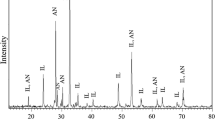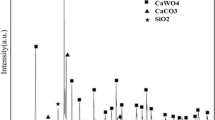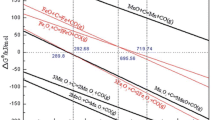Abstract
This study is dedicated to exploring the effect of pH, leaching time, ferrous sulfate amount, temperature, as well as their interaction on the dissolution of cobalt by response surface methodology. The ferrous sulfate was used as an effective reducing agent for the dissolution of heterogenite, which constitutes the main cobalt mineral found in Congolese Copperbelt, and the experiments conducted were based on central composite design. Analysis of variance was carried out to study the effects of the individual variable as well as their combined interactive effects on the recovery of cobalt. The optimum process conditions for the cobalt recovery were determined by a desirability function. The results showed that the amount of ferrous sulfate, leaching time, and leaching temperature were statistically significant as independent linear terms. The results also revealed that the interaction of leaching time and the amount of ferrous sulfate has an important effect on cobalt dissolution. The optimal cobalt recovery was 95.79% at the leaching time of 104.48 min, pH of 1.87, amount of ferrous sulfate of 14.9 g, and temperature of 54.8 °C, while the experiment of validation at these optimum conditions gave the cobalt recovery of 93.82%. This testifies on the goodness of the model developed in this work, thus, verifying that the model is suitable and fits the experimental data with a reasonable error.
Graphical Abstract








Similar content being viewed by others
References
Swartz B, Donegan S, Amos SR (2009) Processing considerations for cobalt recovery from Congolese copperbelt ores. In: Hydrometallurgy conference, pp 385–400
Laznicka P (2010) Giant metallic deposits: future sources of industrial metals, 2nd edn. Springer
Mbuya B, Ntakamusthi P, Bill M, Léon K, Nkulu G (2021) Metallurgical evaluation of the leaching behavior of copper–cobalt-bearing ores by the principal component analysis approach: case study of the DRC copperbelt ore deposits. J Sustain Metall 7(3):985–994. https://doi.org/10.1007/s40831-021-00389-5
Ferron CJ, Henry P (2008) The use of ferrous sulphate to enhance the dissolution of cobaltic minerals. In: Hydrometallurgy 2008: Proceedings of the 6th International Symposium, pp. 1088–1097
Bevandić S, Xanthopoulos P, Muchez P (2021) Chemical leaching of sulfidic mining waste, plombières tailings pond, Eastern Belgium: insights from a mineralogical approach. J Sustain Metall 0123456789. https://doi.org/10.1007/s40831-021-00445-0
Everaert M, Guerrero F, Kamariah N, Spooren J (2021) Fundamental insights in alcoholic ammoniacal systems for selective solvometallurgical extraction of Cu, Zn, and Pb from tailings. J Sustain Metall 0123456789. https://doi.org/10.1007/s40831-021-00382-y
Kasongo KB, Mwanat HM (2021) Application of Taguchi method and artificial neural network model for the prediction of reductive leaching of cobalt(III) from oxidised low-grade ores. S Afr J Sci 117(5):1–8. https://doi.org/10.17159/SAJS.2021/8743
Apua MC, Bafubiandi AFM (2011) Dissolution of oxidised Co–Cu ores using hydrochloric acid in the presence of ferrous chloride. Hydrometallurgy 108(3–4):233–236. https://doi.org/10.1016/j.hydromet.2011.04.012
Ferron CJ (2008) Sulfur dioxide: a versatile reagent for the processing of cobaltic oxide minerals. JOM 60:50–54
Tekin T, Bayramoǧlu M (1993) Kinetics of the reduction of MnO2 with Fe2+ ions in acidic solutions. Hydrometallurgy 32(1):9–20. https://doi.org/10.1016/0304-386X(93)90053-G
Das SC, Sahoo PK, Rao PK (1982) Extraction of manganese from low-grade manganese ores by FeSO4 leaching. Hydrometallurgy 8(1):35–47. https://doi.org/10.1016/0304-386X(82)90029-9
Mbuya BI, Kime MB, Tshimombo AMD (2017) Comparative study of approaches based on the Taguchi and ANOVA for optimising the leaching of copper–cobalt flotation tailings. Chem Eng Commun 204(4):512–521. https://doi.org/10.1080/00986445.2017.1278588
Kime M-B, Kanowa EK, Mulaba-Bafubiandi AF, Diyambi SN (2016) Value recovery from mukondo mine low-grade cobalt ore by heap leaching and solvent extraction value recovery from mukondo mine low-grade cobalt ore by heap leaching and solvent extraction. https://doi.org/10.13140/RG.2.2.35313.28001
Hamzaoui AH, Jamoussi B, M’nif A (2008) Lithium recovery from highly concentrated solutions: Response surface methodology (RSM) process parameters optimization. Hydrometallurgy 90(1): 1–7. https://doi.org/10.1016/j.hydromet.2007.09.005
Herzog MH, Francis G, Clarke A (2019) Understanding statistics and experimental design: how to not lie with statistics. Springer
Montgomery DC (2017) Design and analysis of experiments, Ninth. Wiley, Hoboken
Myers RH, Montgomery DC, Anderson-Cook CM (2016) Response surface methodology: process and product optimization using designed experiments, 4th edn. Wiley series in probability and statistics
Bhattacharya S (2016) Central composite design for response surface methodology and its application in pharmacy. In: Response surface methodology in engineering science design, IntechOpen, pp 1–19
Goupy J, Creighton L (2009) Introduction aux plans d’expériences. Dunod
Simate GS, Ndlovu S, Gericke M (2009) Bacterial leaching of nickel laterites using chemolithotrophic microorganisms: process optimisation using response surface methodology and central composite rotatable design. Hydrometallurgy 98(3–4):241–246. https://doi.org/10.1016/j.hydromet.2009.05.007
Ahmadi A, Rezaei M, Sadeghieh SM (2021) Interaction effects of flotation reagents for SAG mill reject of copper sulphide ore using response surface methodology. Trans Nonferrous Met Soc China (English Ed.), 31(3):792–806. https://doi.org/10.1016/S1003-6326(21)65539-5.
Imoisili PE, Jen TC (2021) Modelling and optimization of the impact strength of plantain (Musa paradisiacal) fibre/MWCNT hybrid nanocomposite using response surface methodology. J Mater Res Technol 13:1946–1954. https://doi.org/10.1016/j.jmrt.2021.05.101
Mbuya BI, Kime MB, Kawama FN, Arad S (2021) Application of the response surface methodology to determine optimal conditions of castine calcination in a full-scale rotary kiln. Miner Process Extr Metall Trans Inst Min Metall 130(2):105–117. https://doi.org/10.1080/25726641.2019.1591792
Li D, Park KH, Wu Z, Guo XY (2010) Response surface design for nickel recovery from laterite by sulfation-roasting-leaching process. Trans Nonferrous Met Soc China (English Ed.) 20(SUPPL.1):s92–s96. https://doi.org/10.1016/S1003-6326(10)60019-2
Jalali F, Fakhari J, Zolfaghari A (2019) Response surface modeling for lab-scale column bioleaching of low-grade uranium ore using a new isolated strain of Acidithiobacillus Ferridurans. Hydrometallurgy 185:194–203. https://doi.org/10.1016/j.hydromet.2019.02.014
Wan Omar WNN, Amin NAS (2016) Multi response optimization of oil palm frond pretreatment by ozonolysis. Ind Crops Prod 85:389–402. https://doi.org/10.1016/j.indcrop.2016.01.027
Yirgu Z, Leta S, Hussen A, Khan MM, Aragaw T (2021) Optimization of microwave-assisted carbohydrate extraction from indigenous Scenedesmus sp. grown in brewery effluent using response surface methodology. Heliyon 7(5):e07115. https://doi.org/10.1016/j.heliyon.2021.e07115
Afolabi FO, Musonge P, Bakare BF (2021) Application of the response surface methodology in the removal of Cu2+ and Pb2+ from aqueous solutions using orange peels. Sci Afr e00931. https://doi.org/10.1016/j.sciaf.2021.e00931
Li YR, Shue MF, Hsu YC, Lai WL, Chen JJ (2014) Application of factorial design methodology for optimization of transesterification reaction of microalgae lipids. Energy Procedia 52:377–382. https://doi.org/10.1016/j.egypro.2014.07.089
Peng C, Hamuyuni J, Wilson BP, Lundström M (2018) Selective reductive leaching of cobalt and lithium from industrially crushed waste Li-ion batteries in sulfuric acid system. Waste Manag 76:582–590. https://doi.org/10.1016/j.wasman.2018.02.052
Kasongo B, Monga J-J, Mwanat H (2021) Implementation of Artificial Neural network into the copper and cobalt leaching process. In: 2021 Southern African Universities Power Engineering Conference/Robotics and Mechatronics/Pattern Recognition Association of South Africa (SAUPEC/RobMech/PRASA), pp 1–5. https://doi.org/10.1109/SAUPEC/RobMech/PRASA52254.2021.9377230
Author information
Authors and Affiliations
Contributions
MH-MM: Conceptualization, Methodology, Software, Validation, Formal analysis, Investigation, Writing—original draft, Writing—review and editing. KBK: Conceptualization, Methodology, Software, Validation, Formal analysis, Investigation, Writing—original draft, Writing—review and editing.
Corresponding author
Ethics declarations
Conflict of interest
The authors declare that they have no conflict of interest or personal relationships that could have appeared to influence the work reported in this paper.
Additional information
The contributing editor for this article was Atsushi Shibayama.
Publisher's Note
Springer Nature remains neutral with regard to jurisdictional claims in published maps and institutional affiliations.
Rights and permissions
About this article
Cite this article
Mwanat, M.HM., Kasongo, K.B. Cobalt Dissolution from Concentrate in Sulfuric Acid—Ferrous Sulfate System: Process Parameters Optimization by Response Surface Methodology (RSM). J. Sustain. Metall. 7, 1838–1851 (2021). https://doi.org/10.1007/s40831-021-00460-1
Received:
Accepted:
Published:
Issue Date:
DOI: https://doi.org/10.1007/s40831-021-00460-1




